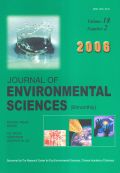Authors: Quan, Xie | Liu, Zhen-yu | Xue, Da-ming | Zhao, Ya-zhi | Yang, Feng-lin
Article Type:
Research Article
Abstract:
A chemical sequential separation procedure for sediment bas been developed for the adsorptive investigation of hydrophobic organic compounds(HOCs) including four fractions: carbonate, hydrous metallic oxide(ferric oxide, manganese oxide and alumina), clay and organic matter. Adsorption isotherms of these hydrophobic solute probes, such as hexachloroethane, lindane and 1,2,4,5-tetrachlorobenzene were measured for model sorbents, model and natural sediment, and the latter of which was pretreated with the simplified sequential separation method. The linear and
…Langmuir models are applied to correlate the experimental data of humic substance and other model sorbents respectively. Multi-component Adsorptive Model (MCAM) was used to simulate adsorption isotherms of model and natural sediment. The results reveal that( 1 ) the separation efficiencies of carbonate, organic matter, ferric oxide, manganese oxide and alumina are 98.1 % , 72.5% ,82.6%, 93.5% and 83.3%, respectively; (2) except for removing metallic oxide, the external structure of sediment is not changed greatly after separation; (3) the MCAM correlates the data of adsorption isotherm rather well with the maximal relative deviations of 9.76 % , 6.78 %and 9.53% for hexachloroethane, lindane and 1,2,4,5-tetrachlorobenaze in model sediment, respectively. The MCAM can clearly give expression to the different adsorptive mechanisms for HOCs in organic and inorganic matter, though the experimental data in each component are not very accurate due to the sequential separation efficiency.
Show more
Keywords: hydrophobic organic compounds, sediment, adsorption, model
Citation: Journal of Environmental Sciences,
vol. 14, no. 2, pp. 195-203, 2002
Price: EUR 27.50





